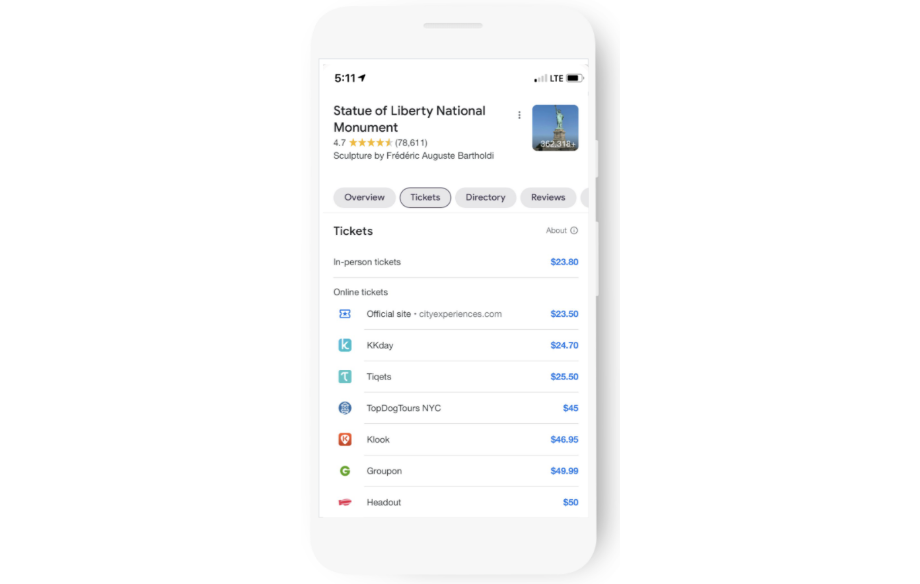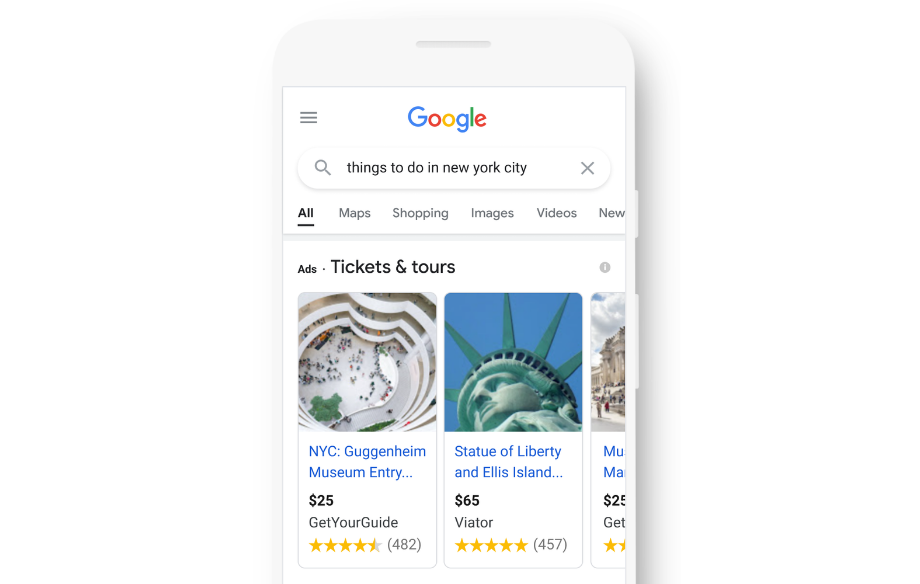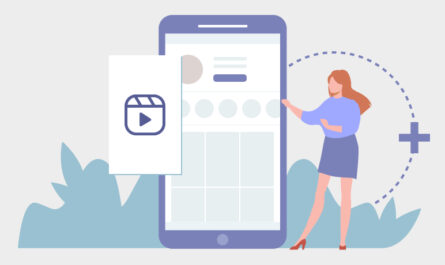
We are continuing to cover what is happening in the world of internet marketing and how it will affect you. Today you will learn about the new Google products: there is a new advertising format for the tourism industry and they are introducing a function through which users can learn more about a particular advertiser and ads. As a result, Google Play (along with the AppStore) may soon cease to be giants of the app market.
First things first.
New travel placement
The travel industry is slowly recovering, and Google is the key. They have added a category called Things to do to the existing tools for promoting travel offers on the Travel Insights platform. It is exciting to see that Google is getting on board with promoting tourism.
Now, when users do a Google search for attractions like the Sydney Opera House or the Statue of Liberty, they will not only see general information about these very popular places of interest but there are also links for booking and other ticket purchase options, if any. This is how it looks:

Also, Google is going to more comprehensively answer the question, «What to do in *anywhere*?» A Google search will display other ads to assist with this search. This wonderful addition to the search engine will uncover interesting places to see, things to do, and lead to an increase in bookings for these attractions. Clearly:

Features of launching «Things to do»
- Before launching, you need to fill out a partner questionnaire in which you will describe the business.
- You can choose a bidding model and set a budget.
- All models are available for these campaigns in Google Ads except Target Impression Share.
- You don’t need to set up targeting manually or select keywords — the algorithm will do it for you.
- Automatic targeting includes two parameters — location and the device from which the user sent the request.
- Ads contain a title — the name of the company or service, a photo, and a link to the landing page.
- Google also collects all these elements automatically.
- There are two placement options for ads: free (great for small businesses) or paid (such ads will be displayed based on the results of an RTB auction as a result of a given bid and the ad quality.)
The new format should be used when working with offers from the «Tourism» category. The main thing is not to forget to check the relevance of free movement before allowing traffic to the site.
More information about advertisements for users
On 22 September, Google announced the launch of its About this ad feature, through which users can learn more about the ads they see, as well as more about the advertisers and all of their advertising campaigns over the previous 30 days. Yes, this is exactly what Facebook introduced two years ago.
Now users have access to more information about the advertisers and their offers. This feature also makes it easier for the users to complain about an ad if they believe it breaks the rules.
Google’s new privacy policy will affect traffic purchases from this source. Even now, the users moderate the content themselves, which means that the demand for high-quality accounts will increase. In addition, they may need more accounts: to work with the same volume of traffic.
But the good news is that these changes will not take effect until 2022. Testing of the About this ad pages will appear in the coming months in the US. So you have time to gather more information and come up with a new strategy.
Decreasing the power of Google and Apple in the app market
Application developers have already compiled a long list of complaints about Google Play and the AppStore: the inability to set the clients’ pricing policies, high commissions (from 15 to 30%), and restrictions on the distribution of applications. That is a monopoly! In addition, there have been several conflicts based on the above so there are precedents.
Finally, the US government has decided to act after it has investigated ways to challenge how Google and Apple have been abusing the market.
A bill was passed in the US Senate aimed at limiting the control these two companies have over app stores. It is called the «Open App Markets Act». According to it, developers have the right to:
- use their payment system for charging applications (not just Google Pay and Apple Pay);
- communicate with application users about «legitimate commercial offers», that is, report a lower price of the application on another site;
- post applications to third-party stores.
This is good news for developers and bad news for Google and Apple. Given past and ongoing disputes, there is a real chance this bill will come into effect soon, (one of the most notorious being Epic Games and its dispute with Apple over the video game Fortnite). In addition, Spotify, Epic Games, and even Elon Musk have supported this initiative. The US authorities seem to be serious since they have decided to team up with the major players to undermine the monopolies held by Google and Apple.
These actions will lead to the appearance of new application platforms. In general, the market can be transformed: new sites are a way of moderating the emergence of monopolies. As a result, all this can lead to changes in the traffic buying model.
By the way, Apple responded that the AppStore is «an unprecedented engine of economic growth and innovation» supporting more than 2.1 million jobs in 50 states. Google said that Android already has other sites besides Google Play.
Well, let’s see what happens next.
Write in the comments what news about Google made the most impression on you. And keep following our trends article.



